Scoliosis
Spinal curvature; Infantile scoliosis; Juvenile scoliosis
Scoliosis is an abnormal curving of the spine. Your spine is your backbone. It runs straight down your back. Everyone's spine naturally curves a bit. But people with scoliosis have a spine that curves too much. The spine might look like the letter C or S.
Images



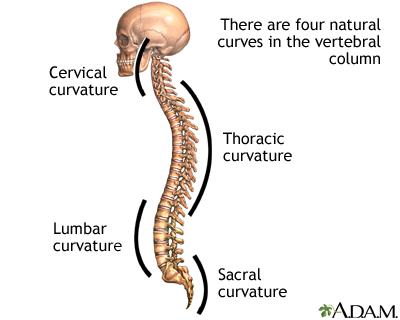
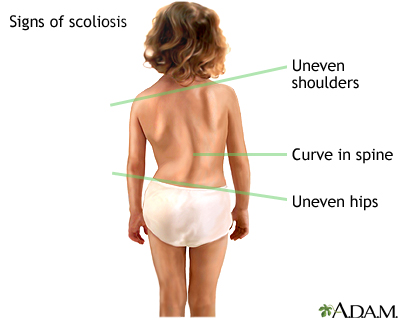
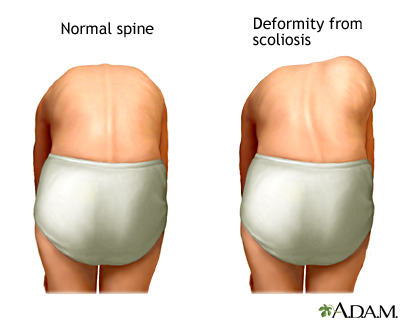
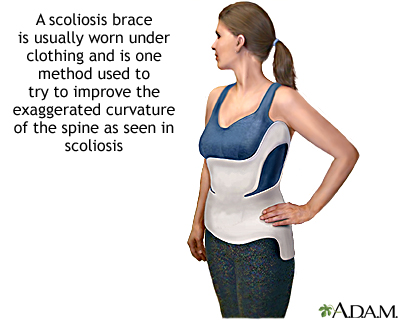
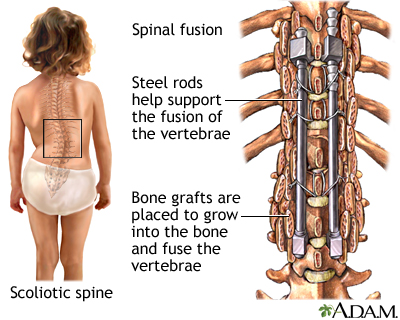
I Would Like to Learn About:
Causes
Most of the time, the cause of scoliosis is unknown. This is called idiopathic scoliosis. It is the most common type. It is grouped by age.
- In children age 3 and younger, it is called infantile scoliosis.
- In children age 4 through 10, it is called juvenile scoliosis.
- In children age 11 through 18, it is called adolescent scoliosis.
Scoliosis most often affects girls. Some people are more likely to have curving of the spine. Curving generally gets worse during a growth spurt.
Other types of scoliosis are:
- Congenital scoliosis: This type of scoliosis is present at birth. It occurs when the baby's ribs or spine bones do not form properly.
- Neuromuscular scoliosis: This type is caused by a nervous system problem that affects the muscles. Problems can include cerebral palsy, muscular dystrophy, spina bifida, and polio.
Symptoms
Most often, there are no symptoms.
If there are symptoms, they may include:
- Backache or low-back pain that goes down the legs
- Weakness or tired feeling in the spine after sitting or standing for a long time
- Uneven hips or shoulders (one shoulder may be higher than the other)
- Shoulder pain
- Spine curves more to one side
- Difficulty with breathing or sitting
Exams and Tests
Your health care provider will perform a physical exam. You will be asked to bend forward. This makes your spine easier to see. It may be hard to see changes in the early stages of scoliosis.
The exam may show:
- One shoulder is higher than the other
- The pelvis is tilted
X-rays of the spine are done. X-rays are important because the actual curving of the spine may be worse than what your doctor can see during an exam.
Other tests may include:
- Spinal curve measurement (scoliometer screening)
- X-rays of the spine to see how flexible the curvature is
- MRI of the spine
- CT scan of the spine to look at the bony changes
Treatment
Treatment depends on many things:
- The cause of scoliosis
- Where the curve is in your spine
- How big the curve is
- If your body is still growing
Most people with idiopathic scoliosis do not need treatment. But you should still be checked by your provider about every 6 months.
If you are still growing, your provider might recommend a back brace. A back brace prevents further curving. There are many different types of braces. What kind you get depends on the size and location of your curve. Your provider will pick the best one for you and show you how to use it. Back braces can be adjusted as you grow.
Back braces work best in people over age 10 with continued growing potential. Braces do not work for those with congenital or neuromuscular scoliosis.
You may need surgery if the spine curve is severe or getting worse very quickly.
Surgery involves correcting the curve as much as possible:
- Surgery is done with a cut through the back, belly area, or beneath the ribs.
- The spine bones are held in place with 1 or 2 metal rods. The rods are held down with hooks and screws until the bone heals together.
- After surgery, you may need to wear a brace for a while to keep the spine stable.
Scoliosis treatment may also include:
- Emotional support: Some children, especially teens, may be self-conscious when using a back brace.
- Physical therapy and other specialists to help explain the treatments and make sure the brace fits correctly.
Support Groups
Seek support and more information from organizations that specialize in scoliosis.
Outlook (Prognosis)
How well a person with scoliosis does depends on the type, cause, and severity of the curve. The more severe the curving, the more likely it will get worse after the child stops growing.
People with mild scoliosis do well with braces. They usually do not have long-term problems. Back pain may be more likely when the person gets older.
The outlook for those with neuromuscular or congenital scoliosis varies. They may have another serious disorder, such as cerebral palsy or muscular dystrophy, so their goals of treatment may be much different. Often, the goal of surgery is simply to allow a child to be able to walk more properly or sit upright in a wheelchair.
Congenital scoliosis is difficult to treat and usually requires many surgeries.
Possible Complications
Complications of scoliosis can include:
- Breathing problems (in severe scoliosis)
- Low back pain
- Lower self-esteem
- Persistent pain if there is wear and tear of the spine bones
- Spinal infection after surgery
- Spine or nerve damage from an uncorrected curve or spinal surgery
- Leakage of spinal fluid
When to Contact a Medical Professional
Contact your provider if you suspect your child may have scoliosis.
Prevention
Routine scoliosis screening is now done in middle schools. Such screening has helped detect early scoliosis in many children. Back and abdominal muscle strengthening can help stabilize the curvature.
Related Information
LateralMuscle function loss
Cerebral palsy
Muscular dystrophy
Polio
Fatigue
Respiratory
Anesthesia - what to ask your doctor - child
References
Buell TJ, Lark R, Smith JS, Shaffrey CI. An approach for treatment of complex pediatric spinal deformity. In: Steinmetz MP, Berven SH, Benzel EC, eds. Benzel's Spine Surgery: Techniques, Complication Avoidance, and Management. 5th ed. Philadelphia, PA: Elsevier; 2022:chap 143.
Mistovich RJ, Spiegel DA. The spine. In: Kliegman RM, St. Geme JW, Blum NJ, Shah SS, Tasker RC, Wilson KM, eds. Nelson Textbook of Pediatrics. 21st ed. Philadelphia, PA: Elsevier; 2020:chap 699.
Negrini S, Di Felice F, Donzelli S, Zaina F. Scoliosis and kyphosis. In: Frontera WR, Silver JK, Rizzo TD Jr, eds. Essentials of Physical Medicine and Rehabilitation: Musculoskeletal Disorders, Pain, and Rehabilitation. 4th ed. Philadelphia, PA: Elsevier; 2019:chap 153.
BACK TO TOPReview Date: 8/12/2023
Reviewed By: C. Benjamin Ma, MD, Professor, Chief, Sports Medicine and Shoulder Service, UCSF Department of Orthopaedic Surgery, San Francisco, CA. Also reviewed by David C. Dugdale, MD, Medical Director, Brenda Conaway, Editorial Director, and the A.D.A.M. Editorial team.

Health Content Provider
06/01/2025
|
A.D.A.M., Inc. is accredited by URAC, for Health Content Provider (www.urac.org). URAC's accreditation program is an independent audit to verify that A.D.A.M. follows rigorous standards of quality and accountability. A.D.A.M. is among the first to achieve this important distinction for online health information and services. Learn more about A.D.A.M.'s editorial policy, editorial process and privacy policy. A.D.A.M. is also a founding member of Hi-Ethics. This site complied with the HONcode standard for trustworthy health information from 1995 to 2022, after which HON (Health On the Net, a not-for-profit organization that promoted transparent and reliable health information online) was discontinued. |
The information provided herein should not be used during any medical emergency or for the diagnosis or treatment of any medical condition. A licensed medical professional should be consulted for diagnosis and treatment of any and all medical conditions. Links to other sites are provided for information only -- they do not constitute endorsements of those other sites. © 1997- 2025 A.D.A.M., a business unit of Ebix, Inc. Any duplication or distribution of the information contained herein is strictly prohibited.
